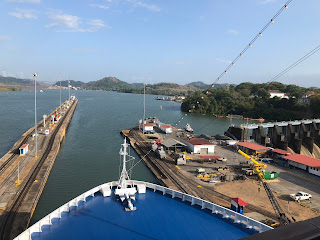Let's pick up where we left off. Our hero and his lovely companion, boarded the MS Marina on Monday, March 18th. They then unpacked and spent the rest of the day reacquainting themselves with the ship. This would be their third cruise aboard her. Then later that evening, the Capitan and his experienced international crew would get underway and steer a northerly course, to the first stop at Trujillo, Peru. The next morning, the ship docked at a beautiful piece of man-made infrastructure, next to a coal freighter. For Gym, it was nice to see the Peruvians exporting coal, without protest from anyone.
The stop in Trujillo included a half-day tour of the Moche ruins, a wonderful Peruvian lunch, a Paso horse show, a demonstration of the Marinera dance and a ten-minute drive down the Pan-American highway.
Trujillo is the third largest city in Peru. It is located in the green Moche valley which punctuates a very arid strip of land, on the western slopes of the Andes. This arid zone runs almost the entire length of the country and is referred to as the great Sechura Desert. The Moche river runs down the centre of the Moche valley and it is here that the modern Trujillo endures. The valley also supported the ancient Moche civilization until its demise in the 7th Century AD. The Moche archeological sites are on the outskirts of the city, a short drive from the port.
The Moche people existed for about six or seven hundred years from the 1st Century AD. They primarily worshiped the sun and the moon and sacrificed their own people to these gods. These sacrifices were to basically to guarantee no devastating climatic events in the future. Unfortunately, as the scientists have determined, a particularly long and harsh El Nino cycle at the end of the 6th century may have ended the civilization in spite of all the sacrifices. The Moche people did some good work while they were around in spite of the short lifespan of the civilization. In the grand adobe moon temple which was built up over several centuries, intricate artwork was evidenced and depictions of the gods, Moche people, rainbows, spiders, snakes, lobsters and hairless dogs were observed. Gym and Mrs. Gym viewed much of this with Maritza, a great local guide. They got credit for several flights of stairs as well.
The author has another theory on the collapse of the Moche civilization. A Liberal High Priest started rounding up the wood gatherers and sacrificing them instead of the warriors. Then a cold wind blew in from the Andes and they all froze their butts off...................sorry, back to our intrepid travellers.
Next to the ruins is a beautiful hacienda where catering facilities have been established. There, our heroes were served a colourful Peruvian meal, in a ranch-style setting, with a nice green lawn on one side and adobe horse paddocks on the other. After lunch, they were treated to a demonstration of just how proud and smart a Paso horse can be when trained and handled properly by the smartly-attired Peruvian vaqueros. Three local vaqueros provided some flawless Peruvian dressage for the occasion. Then a young Peruvian couple danced the Marinera for the travellers and the fetching young female dancer concluded the entertainment by dancing with a vaquero, on horseback (sounds weird but it worked).
Gym and his fetching wife, returned to the ship after the Trujillo tour and left Peruvian soil for the last time, on this voyage. The MS Marina would leave Peru that evening and once again, run out onto the vast Pacific Ocean. It would sail without stopping for 36 hours, as Wednesday was a sea day. So the ship spent the whole next day and night inching closer to Ecuador where it would make a stop in Manta, Ecuador before it crossed the equator.
Wednesday, March 20, was a fantastic day at sea. The mighty Pacific was quite quiet and calm. The winds were following winds from the south and the temperature was a constant 26C. Early in the morning on March 21, the ship arrived in Manta and docked again in a lovely port facility. Gym and Mrs. Gym were scheduled to tour Manta and the nearby area, on their first visit to Ecuador.
Stay tuned!
 |
| Leaving Callao (Lima) and a massive container loading facility |

































































